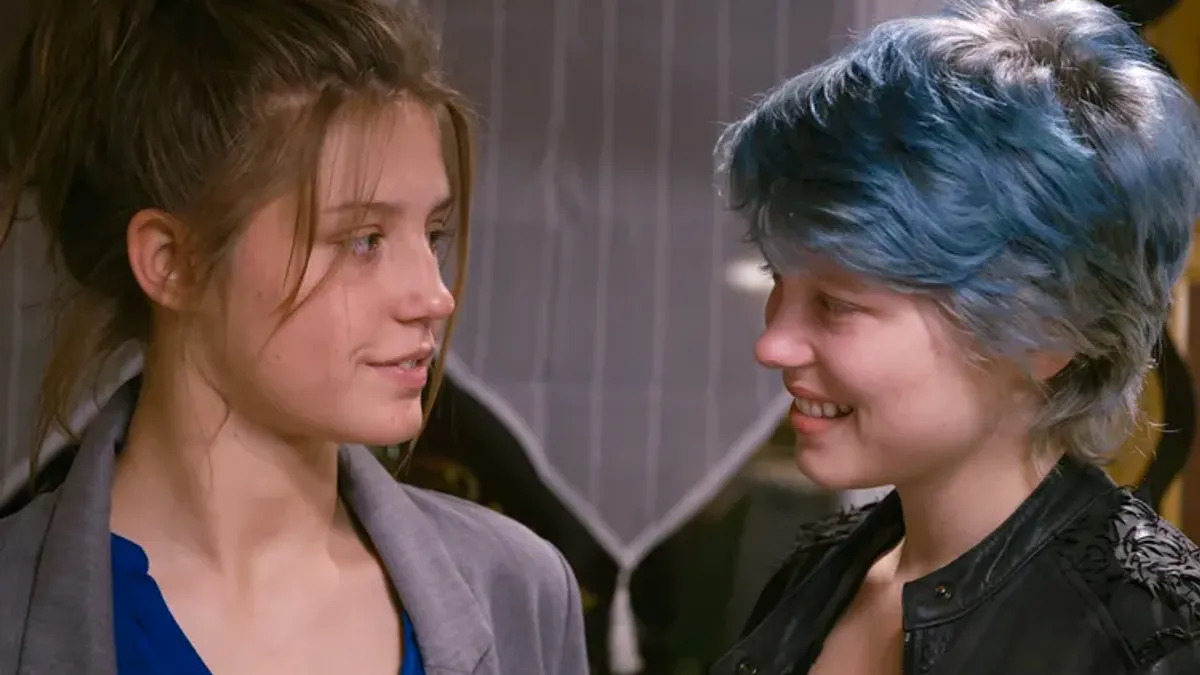Jul Maroh’s Blue Is the Warmest Color is just so beautiful. It’s maybe a bit naive in its perspective — it’s clear it’s a creator’s first solid work — but that infuses it with a certain heartfelt sweetness. It’s a tale of first love and self-discovery for both the characters and the creator.
Clementine is a high school student in the mid-1990s trying to find her place in the world. She falls into a relationship with Thomas, mostly out of pressure from her friends, but it’s obvious from the beginning she’s not really feeling much toward him. A young blue-haired woman, Emma, catches her eye and after a series of near-misses, they meet each other in a bar and their connection is strong. Of course, Emma has a girlfriend and Clementine wants to be straight.

All of this eventually leads to Clementine being kicked out of her house.
Most of the story is told in flashback until this point (Clementine’s journals provide the narration) and when the story catches up to 2008, not everything is going well between Clementine and Emma. Most of the drama between them is off-panel, but it’s easy enough to fill in the mundane details of a relationship that stops being fulfilling for either one of them. I’m not particularly sold on the ending (Clementine basically dies of a broken heart) but I also find it oddly honest. Maroh was just discovering their voice and that’s always the easier way to end the story.
Maroh’s art is manga-inspired, with big eyes and expressive mouths on the characters, but they do make the style their own. Maroh has a gift for the subtleties of body language and facial expressions. The physicality of the first time Clementime and Emma have sex is used to create something beautiful and powerful. Color is also used to great effect here. The flashbacks are sepia-toned with pops of blue (especially Emma’s hair) are lovely and the drab color palette of the 2008 sequence reflects the characters’ melancholy.
On the surface, the story should work effectively as a movie, but Abdellatif Kechiche’s Blue Is the Warmest Color (2013) is mostly an odd mess and one that doesn’t do the tenderness of the graphic novel justice.
Clementine has been renamed Adèle (Adèle Exarchopoulos) but the character is mostly the same. Exarchopoulos plays her with an open-heartedness that works well for the character, and as much as I get her sloppy eating is meant to be symbolic the hunger she has for life (or something), it’s a bit much and fairly gross (I’m not even one who’s particularly bothered by such things). Léa Seydoux does play Emma with a sexy confidence that’s also vulnerable and kind, but the character is underwritten for the most part.
The first half of the movie mostly follows the first half of the graphic novel, although Adèle isn’t kicked out of her house. The second half expands upon Adèle and Emma’s adult life together, but Adèle has mostly become an insecure mess and jealous of the attention Emma receives. It comes across as weird.
Adèle does cheat on Emma like she did in the graphic novel, but their verbally violent confrontation feels out of place for both characters, with Emma shouting at Adèle that she’s a slut and a whore. Graphic novel Emma was angry at the betrayal, but it seemed like it came from an intense place of hurt. Movie Emma just seems abusive.
There are many other subtle missteps this movie makes. Adèle is too isolated in her adult life and it feels weird she has no friends outside of Emma. Also, the movie is three hours long for no real reason. Just about every scene goes on for a beat or two too long. Conversations last far longer than they need to and we’re shown much more of Adèle teaching than is necessary to understand she likes her job. It always feels like Kechiche wants his audience to make sure they get the point when the point is already pretty obvious. There isn’t much that’s particularly subtle here.
Adèle doesn’t die at the end, which I thought was good, but her future seems pretty aimless and unclear.
So yes, the sex scenes. They’re notorious in this movie. And also kind of pointless. There’s no intimacy or real connection. It’s just sex. The only thing I appreciated about them was that they reflected real sex is often chaotic and messy but even that had its limits. It mostly just felt like the director wanted to have his two lead actors simulate sex with each other because he could (and a late scene with Exarchopoulos taking a shower just seems to be there so we can see her naked again).
The sex scene in the comic was pivotal in that it showed the intimate connection that Clementine and Emma had with each other. The movie just has sex scenes that are there. They aren’t adding to the plot or the characters. They’re not even particularly erotic. I got bored, honestly. (And there was one scene, post-break up, the two are nearly having sex in the middle of a restaurant and … what?)
While both the lead actresses walked back some of their statements about Kechiche’s behavior, both seemed to agree it was not an easy shoot. (There were also allegations from the film’s crew of harassment and labor violations.) Maroh also had mixed opinions about their experience with the making of the film and the aftermath of it.
So yeah, hey, it’s cool a movie based on a graphic novel won the Palme d’Or. It’s just too bad it was this movie in particular.
The graphic novel is still great, though.

